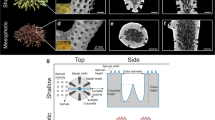Abstract
THE scleractinian coral Fungia scutaria produces a dense, diskoid skeleton that is adapted for stability and abrasion resistance in turbulent water. Water motion rights skeletons at velocities lower than needed to disturb upright corals. Flow of water over the coral is controlled largely by passive hydro-mechanical adaptations. Previous reports1–3 suggest that muscular activity is the main mechanism enabling free-living solitary corals to follow their peculiar way of life. Our work indicates that passive hydromechanical adaptations can be a more important factor in shallow turbulent waters. Several species of free-living corals are known to migrate, avoid burial, and right themselves by action of their polyp1,2 or by symbiotic activity of sipunculid worms3. Most other Indo-Pacific solitary corals such as F. scutaria are inactive, yet remain upright in turbulent waters. Dead skeletons of F. scutaria are generally found with the oral surface upward, and seem to resist erosion far better than other corals. We overturned dead skeletons in one area; they were righted during the next period of heavy waves, suggesting unique hydraulic and structural properties of the skeleton.
This is a preview of subscription content, access via your institution
Access options
Subscribe to this journal
Receive 51 print issues and online access
$199.00 per year
only $3.90 per issue
Buy this article
- Purchase on Springer Link
- Instant access to full article PDF
Prices may be subject to local taxes which are calculated during checkout
Similar content being viewed by others
References
Abe, N., Palao. Trop. Biol Stud., 1, 671–694 (1939).
Hubbard, J. A. E. B., Nature, 236, 457–459 (1972).
Goreau, T. F., and Yonge, C. M., Nature, 217, 421–423 (1968).
Nagle, J. S., J. Sediment. Petrol., 37, 1124–1138 (1967).
Menard, H. W., and Boucot, A. J., Am. J. Sci., 249, 131–151 (1951).
Abe, N., Palao. Trop. Biol Sta. Stud., 1, 469–521 (1938).
Jokiel, P. L., Maragos, J. E., and Franzisket, L., Handbook of Coral Reef Research Methods (edit. by Stoddart, D. R., and Johannes, R. E.) (UNESCO Monographs on Oceanographic Methodology, in the press).
Driscoll, E. G., J. Sedim. Petrol., 37, 1117–1123 (1967).
Author information
Authors and Affiliations
Rights and permissions
About this article
Cite this article
JOKIEL, P., COWDIN, H. Hydromechanical adaptation in the solitary free-living coral Fungia scutaria. Nature 262, 212–213 (1976). https://doi.org/10.1038/262212a0
Received:
Accepted:
Published:
Issue Date:
DOI: https://doi.org/10.1038/262212a0
This article is cited by
-
Mushroom to manoeuvre? Using photogrammetry to track the movement and survival of free-living corals
Coral Reefs (2023)
-
Wave-swept coralliths of Saba Bank, Dutch Caribbean
Marine Biodiversity (2018)
-
Mobility and self-righting by a free-living mushroom coral through pulsed inflation
Marine Biodiversity (2016)
-
Phototaxis in Fungiidae corals (Scleractinia)
Marine Biology (1995)
-
Migration, habitat use, and competition among mobile corals (Scleractinia: Fungiidae) in the Gulf of Eilat, Red Sea
Marine Biology (1992)
Comments
By submitting a comment you agree to abide by our Terms and Community Guidelines. If you find something abusive or that does not comply with our terms or guidelines please flag it as inappropriate.



